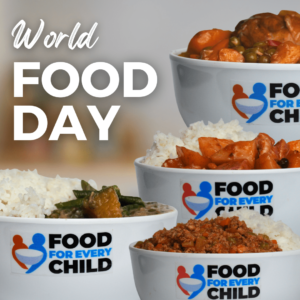
World Food Day: Let’s Build a Hunger-Free World for All Children
In the spirit of World Food Day, we stand united to combat child hunger and its far-reaching consequences. Join us on this journey towards a brighter, nourished future for every child.

A global crisis brought on by high food prices is pushing millions more people into extreme poverty and amplifying hunger and malnutrition. The COVID-19 pandemic, according to a World Bank report, significantly hampered efforts to reduce worldwide poverty. Since 2019, the number of people experiencing acute food insecurity has increased from 135 million to 345 million, meaning that as many as 828 million people go to bed hungry every night.
A total of 50 million people in 45 different nations are on the verge of famine. Now, the war in Ukraine has interrupted about a third of the world’s wheat market, exacerbating an already dire food security situation aggravated by COVID-19. Climate shocks, armed conflict, and global health concerns will drive food commodity prices to their greatest levels ever if quick aid is not provided.

Typical food for an entire family of four in communities in tropical Asia
Hunger is reaching record highs as a result of the COVID-19 pandemic’s economic impacts. A potentially deadly confluence of four elements is to blame for this catastrophic hunger crisis:
The majority of those who are hungry around the world still experience it as a result of conflict, with 60% of them residing in violent or war-torn regions. The situation in Ukraine provides evidence of how war fuels hunger by driving people from their homes and destroying their means of income.
Costs are also at an all-time high. A startling 44% increase puts the World Food Program’s monthly operational costs $73.6 million above their 2019 average. Previously, the additional operational expense would have provided one month’s worth of food for 4 million people.
World food prices rose at the quickest rate ever in March 2022, rising nearly 13% to a new record high. Low-income nations, which are already struggling to recover from COVID-19 and rely on moderately priced wheat, vegetable oils, and other food staples, will bear the brunt of price increases. This is putting import-dependent countries in the Middle East and Northern Africa on the verge of collapse.
Climate shocks kill people, destroy crops, and weaken people’s capacity to feed themselves.
Governments must put a stop to the conflict before allowing relief organizations to reach the most vulnerable people and save lives right away. As they recover from the pandemic, they must also establish a more equitable and sustainable global economy. These fundamental causes of hunger must be addressed, as well as the underlying injustices that deepen the gap between the rich and the poor.
They must concentrate their efforts on providing social safety rather than purchasing weapons that exacerbate hunger and violence. The equivalent of $8 billion, or just one day and a half of our current global military spending, could pay for the full UN emergency food security appeal.
As part of an all-encompassing international response to the ongoing food security crisis, the World Bank Group is also making up to $30 billion available over a 15-month period in areas such as agriculture, nutrition, social protection, water, and irrigation.
Initiatives will be launched with this financing to enhance food and fertilizer production, strengthen food systems, stimulate commerce, and aid producers and disadvantaged households.
The World Bank Group and the G7 Presidency co-convened the Worldwide Alliance for Food Security in May, with the goal of catalyzing an immediate and coordinated response to the global hunger crisis.

In order to address the issue of global food security, the U.S. Agency for International Development (USAID) is collaborating with multisector partners through its Feed the Future programming. USAID made an announcement about a $5 billion investment in Feed the Future over the next five years at the United Nations Food Systems Summit in 2021.
Along with this investment, USAID also unveiled a partnership plan with the US International Development Finance Corporation (DFC) and the Eleanor Crook Foundation to raise $100 million in funding for programs that address the root causes of malnutrition as well as the impact of COVID-19 on malnutrition and food insecurity in developing countries.
In Bangladesh, Feed the Future is collaborating with a major seed supplier in the country’s south to provide smallholder farmers with the resources and ingredients they need to cultivate nutritious crops.
USAID is delivering over $114 million in humanitarian aid to East Africa, including food, medical supplies, and clean water. More than 20 million people in the region will require emergency food assistance this year, a 70% rise over 2017.
In Nepal, Feed the Future improved food security during the COVID-19 pandemic by connecting Nepali farmers and business owners with online delivery firms. This has allowed smallholder farmers to retain crop sales while also providing local families with nutritional food sources.
In order for WFP to continue saving lives in times of crisis, as well as to increase families’ and communities’ capacity for self-sufficiency in food production and reduce their need for humanitarian aid, levels of humanitarian and development assistance must be increased. Money alone, though, won’t be enough to end world hunger. Conflict resolution is only possible with political will in areas like Ethiopia, Yemen, and South Sudan. The primary causes of hunger will persist unabated in the absence of a strong political commitment to limit global warming as recommended by the Paris Agreement.

In the spirit of World Food Day, we stand united to combat child hunger and its far-reaching consequences. Join us on this journey towards a brighter, nourished future for every child.

Ensuring that every child has access to nutritious meals is not just a matter of physical health but also a fundamental building block for their mental and emotional well-being.

In countries with easy access to food, millions of children still suffer from malnutrition. This crisis often stems from the stark difference between empty calories and nourishing meals.
Adding {{itemName}} to cart
Added {{itemName}} to cart